Designers of hydraulics circuits are typically tasked with ensuring that hose and connections are safe, efficient, leak free and easy to maintain. And it goes without saying that they need to be cost effective and last a long time.

Swiwell hydraulic swivel connections. Image courtesy of Taimi Hydraulics
That’s readily accomplished when a properly sized hose is stationary and well protected yet easily accessible. Things get a bit dicey when everything moves. Machines in motion — whether it’s a robot arm or excavator bucket — can let hoses rub and abrade against each other and on machine components, as well as lead to extreme bending and high stresses that can cause a hose to prematurely fail.
Swivel-type fittings are designed to head off such problems. They permit the coupling and hose connection to rotate and prevent twisting and kinking, compensate for hose length changes when the system pressurizes, reduce system rigidity and help absorb hydraulic surges and shocks in a line. Added up, that can cut downtime and extend hose life.
The products also foster more-economical circuits. Swivels can reduce the length of hose required between connections, eliminate the need for bent tubing to accommodate angled connections, and often can connect directly to the hose line without adapters. Many times this leads to less-complex, more-efficient system plumbing, as well as simpler and quicker installation.
A swivel itself consists of a housing and stem that rotate relative to one another, as well as the requisite internal seals and bearings that are critical to trouble-free operation. Two basic types are in-line swivels, where the stem and housing fluid ports lie on a common axis; and 90° swivels, where the housing’s fluid port is positioned to rotate on a plane 90° to the stem axis.
The swivel or hose should mount to the machine structure to ensure proper alignment and freedom of movement. While swivel joints are typically designed to allow free rotation with minimal friction, engineers should be aware that the weight of the attached hose, tubing or fittings — as well as the weight of the contained hydraulic fluid — may be substantial enough to place excessive side loads or bending moments on the swivel. The connection must be built to handle such loads or the seals may prematurely wear and leak.
Excessive side loading also accelerates wear on the bearing surfaces and inhibits smooth swivel joint operation. Even when used as intended, however, the seals, back-up rings and bearings can eventually wear out, but many designs permit simple repair with seal replacement kits.
Today’s swivel products come in a range of end connections with various housing materials and seal options to suit the intended application. Here’s a look at some typical offerings on the market today.
Multiple designs
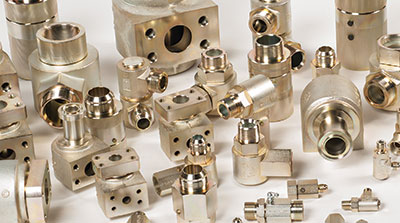
In addition to making various inline and 90° products, Hydraulics Inc. offers flange swivels. These fluid-conducting swivel joints incorporate SAE 4-bolt flange connections per SAE J518 Code 61 and Code 62.
Fluid-conducting swivel joints from Hydraulics Inc., Fort Worth, Texas (www.hydraulicsinc.com) come in a number of sizes and flow capacities with pressure ratings as high as 6,000 psi. That includes many combinations of connectors for SAE and ISO fluid ports.
These products are generally considered for low-speed rotation in fluid power systems. Maximum speed of rotation depends upon system environment, with fluid type, temperature and pressure being prime consideration, according to the company.
The Hydraulics Inc. inline-type swivel has opposed fluid ports on a common axis with axial ball-bearing raceways and seal grooves machined into the barrel and stem. Relative motion depends on a single load-bearing mechanism, a combination radial-thrust bearing. When assembled, the balls retain the barrel to the stem while permitting axial rotation between the two components. Thus, the bearings must withstand both thrust and stress from angular deflection of piping. With no deflection, bearing life is a function of thrust from fluid pressure.
The S-Inline swivel, for example, features a hardened carbon-steel barrel and stem with large wear surfaces, chrome retainer balls for long life and a burnished barrel bore for extended seal life. It includes a standard O-Ring and back up ring that are field replaceable. Protective treatment is zinc plating with a RoHS-compliant yellow chromate finish. An optional grease fitting is available. Maximum working pressure is 3,000 psi (207 bar).
HS-series in-line swivels offer expanded performance over the standard S-series. This heavy-duty product operates at pressures to 5,000 psi with a 4:1 safety factor. It offers: an enhanced bearing design along with a dual-ball race that improves side-load resistance; higher-strength, thanks to a through-hardened alloy steel barrel and stem; a large wear surface that limits angular deflection and rotational torque; and permanently lubricated bearings. These features reportedly result in extremely long life even in severe applications.
Hydraulics Inc.’s 90°-type swivels have two load-bearing journal bearings. The swivel’s barrel bore and stem have complementing load-bearing lands, and equal-size seals for containing the fluid. By nature of equal (pressure balanced) seal size, fluid pressure on the stem and barrel induces no load on the bearings. Thus bearing life depends solely on external loading. Minimizing angular deflection helps ensure long bearing life.

Super Swivels’ extensive line of rotating joints include Extra Heavy Duty versions built for extreme applications and units
for pressures to 10,000 psi.
The 9S-90° Series swivels come in an extensive range of sizes and configurations and operate at pressures to 5,000 psi. All are designed with a 4:1 safety factor and include RoHS compliant zinc plating for corrosion protection. Related products are the 9SS-Dual Plane and 18S-Parallel Plane swivel families. Finally, the company offers flange swivels. These fluid-conducting swivel joints incorporate SAE 4-bolt flange connections per SAE J518 Code 61 and Code 62.
High-pressure options
Super Swivels, Minneapolis, (www.superswivels.com) makes a range of hydraulic live swivels with features like chrome or stainless-steel ball bearings, side-load resistance, burnished (micro smooth) barrel bores and minimal pressure drop. Rebuild kits are available to extend a swivel’s useful life.
The products are used across many applications, for example in hose reels, log loaders, automatic car washes and machine tool indexers to hydraulic wheel motors, robots, and railroad and mining equipment.
Compact inline swivel rotating joints enable movement of hoses and piping in fluid power systems and are designed to fit in tight areas. A one-piece barrel and stem with integrated ball-bearing races minimizes friction, withstands heavy side loads and prevents premature seal wear and leaks. This pass-through inline design is considered the most standard configuration in live swivels, and sizes range from 0.12 to 2.5 in. in numerous body thread and end configurations.
Super Swivel 90° swivels permit free rotation around sharp corners with little flow restriction. Sizes range from 0.12 to 2.0 in. Dual Plane swivels are rotating joints that provide free rotation on two axes with a right-angle change of path. They let hoses and piping move on two paths. Sizes range from 0.25 through 1.5 in. ends.
Extra Heavy Duty swivels are for extreme applications. They have a multiple-bearing race design for added load-bearing support and side-load strength. The inner and outer bearing races are integrally designed and machined with tight tolerances into the hardened male stem and female body, providing a rigid track for the balls to roll freely, yet securely. Other versions of the company’s products include high-pressure swivels rated to 10,000 psi; and BSPP (British Standard Pipe Parallel Thread) designs.
The swivels are manufactured from carbon steel and 304 and 440c stainless steel. Carbon-steel zinc plating is recommended for non-corrosive applications, such as typical hydraulic or pneumatic duty. Carbon-steel nickel plating is recommended for mildly corrosive environments that include water, mild chemicals and solvents. 304 stainless handles low-pressure corrosive environments. 440c is a heat-treated, high-carbon, martensitic stainless steel for high-pressure duty, although it is less corrosion resistant than 300 series stainless.
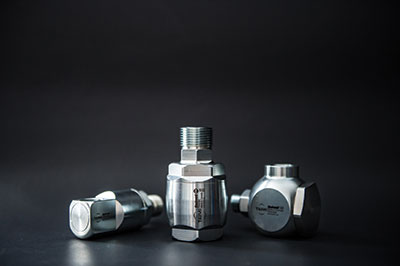
Taimi’s Swiwell hydraulic swivels are designed to eliminate torsion on hydraulic hoses. They do not use ball bearings and thus are said to be more robust and durable for enduring extreme operating conditions.
Viton (fluorocarbon) seals are recommended for most petroleum-based applications with operating temperatures from -15° to 250° F; Aflas (tetrafluoroethylene-propylene copolymer) for higher resistance to many chemicals and high-temperature environments to 400° F; and Extreme Viton that offers good resistance to many chemicals and temperatures from -6° to 437° F. Optional seals materials include Buna, EPR, Neoprene and Markez.
Ball-less couplings
Taimi Hydraulics, St-Prime, Quebec (www.taimi.ca) has developed a family of ball-less swivel couplings that are said to be pressure-spike protected and can reliably withstand significant lateral and tear loads. A triple-seal design enhances leak resistance and, if necessary, the swivels can be quickly repacked.
They are made for high-pressure circuits in a wide array of applications from marine and offshore, robots and cranes, underground and surface mining to construction, demolition, forestry, agricultural and railway operations.
Taimi’s Screw-in Cartridge swivel is designed to be integrated into hydraulic manifolds. It simply screws in, becoming a short and sturdy swiveling coupling that withstands side loads and pressures to 6,000 psi. The company’s standard 90° Swivel series offers right-angle connections with the same features as the inline version. Taimi’s short-series 90° Swivel is built to fit in narrow and hard-to-reach spaces.
The Swiroll spherical hydraulic joint aims to improve hose group reliability on rotating attachments. It can replace a static manifold or hydraulic junction block, for example, on harvesting heads. The company says Swiroll reduces downtime, improves safety, cuts oil consumption and eliminates hose twisting, and can substantially lower hydraulics-related costs.
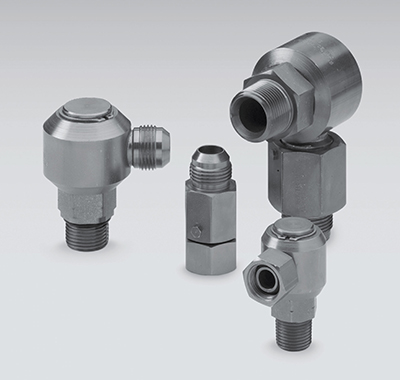
Live swivels manufactured by Tompkins Industries include inline, 90° and dual-plane versions. They’re available with many combinations of male and female pipe, NPSM, JIC and O-ring face seal connections.
Dual Swivel Manifolds house two Screw-in Cartridges swivels. Designed to be bolted or welded together, they are used in many applications where hoses are quickly wearing or loosening due to torsion or pulsating pressure. 90° or 45° fittings can be installed on both the swivel and static side of the manifold. In addition, custom Swivel Manifolds, again housing Screw-in Cartridge swivels, offer greater design freedom in specific applications such as harvester booms and forwarders.
Versatile connections
Live swivels manufactured by Tompkins Industries, Olathe, Kansas, (www.tompkinsind.com) are suitable for vacuum service and for applications with operating pressures to 3,000 psi. The product offerings include inline, 90° and dual-plane versions. End configurations come in various combinations of male and female pipe, NPSM, JIC and O-ring face seal connections.
Sizes generally range from as small as 0.25 to 2.50 in. connections, but actual offerings vary by specific end specification. The swivels are available in zinc-plated steel, 316 stainless, and brass. Seals are typically Nitrile with Viton available on request. Temperature range is -40° to
200° F.
Increasing safety

Stauff FI-DGWESV swivel fittings compensate for movements between a fluid line and machine component, providing for continuous freedom of movement during operation. Image courtesy of Walter Stauffenberg GmbH & Co. KG
Stauff, Waldwick, N.J., (www.stauffusa.com) developed its male-stud swivel elbows to extend its range of tube fittings capabilities. These connectors introduce continuous freedom of movement into the hydraulic line that further increases leak safety of a system.
The compact FI-DGWESV swivel fittings compensate for rotating, pivoting and oscillating movements between a line and machine component during operation, for instance for the tension-free connection of pressurized hose lines. They also prevent torsion build-up or extremely tight bend radii on moving hose lines.
The connection on one side of the swivel elbow is a 24° inner cone (form “W” as per DIN 3861) in sizes 6L to 42L (Light Series) and 6S to 38S (Heavy Series). The opposite side can be fitted with a Whitworth pipe thread (G1⁄8 to G1-1⁄2) or a metric thread (M10x1 to M48x2) with a profiled seal. NBR seals are standard, although alternative materials as well as different connection versions are available.
A self-lubricating slide bearing permits rotating movement. It relies on the system fluid as a lubricant, making the bearing completely maintenance-free. Rotational speed in continuous operation depends on the size and operating conditions.
The swivel fittings withstand operating pressures up to 400 bar (5,800 psi) with a general safety factor of 2.5, depending on the series and body size. Like the complete Stauff fittings range, they boast a high-grade zinc/nickel coating that meets stringent requirements in terms of corrosion protection and appearance.
Plug-in swivels
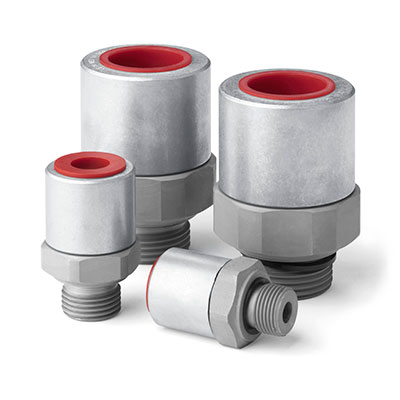
CEJN’s Series 860 Plug-In swivels enable quick and safe hydraulic hose kit assembly without tools.
Click-to-connect WEO Plug-In hydraulic fittings from CEJN (www.cejn.com) are used in many applications ranging from larger front loaders, skid steers, fork-lifts and more. The leak-free products are designed to drastically reduce installation time and are often used when limited assembly space is a critical issue. The self-aligning plug-in fittings offer multiple connection configurations for new user and existing system designs, and it enables quick and safe hydraulic hose kit assembly without tools. Additionally, the WEO Plug-In standard fittings have a slight swiveling function to allow the hose to find its natural relaxed position at assembly.
In areas where full swiveling is required under working pressure, the WEO Plug-In swivel series is designed for these applications that must be permitted to move. The swivel can rotate 360° under working pressure. It includes a combined ball and slide bearing, accommodating both hydraulic and torsion forces for longer service life. As both a swivel and plug-in fitting, it offers a size and weight advantage over other commonly used swivels, according to CEJN.
All CEJN WEO Plug-In fittings (including the WEO Plug-In swivel series) are produced out of steel with a zinc-nickel protective surface. The standard range uses NBR seals, but other sealing materials are available. Pressure rating is 5,076 psi for -06 (0.38 in.), -08 (0.50 in.), and -12 (0.75 in.), and
3,625 psi for -16 (1.0 in.).
Flexible hose connections
While not a classic swivel connector, the Quick-Connect system from ARGO-HYTOS, Kraichtal, Germany (www.argo-hytos.com) nonetheless offers a flexible alternative to conventional hose connection fittings.
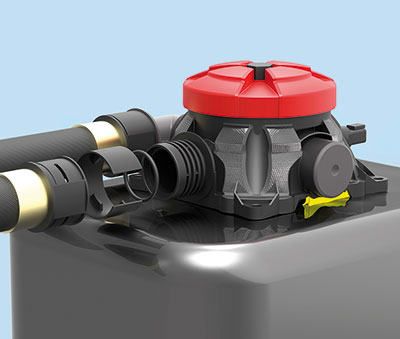
Tubes and hoses fitted with ARGO-HYTOS Quick-Connect connections are simply plugged into the appropriate adapter and fixed with locking clips. The hose cannot pull off, but can rotate to prevent twisting.
Tubes and hoses equipped with these connections can be simply plugged into the appropriate adapters by the user and fixed with locking clips. Thus, assembly is significantly faster than required for conventional fittings and no tools are needed.
The locking clip prevents the hose from pulling off the adaptor. However, the line can rotate in the radial direction. In many applications this offers an advantage because the line can thus be positioned as free of stress as possible. In contrast, hose that is installed twisted or poorly routed tends to have a shorter working life. Likewise, the
system works well in narrow and tight spaces thanks to a minimum hose spacing and by the rotatability of the line.
The modular Quick-Connect system was introduced several years ago for use in large agricultural and construction machines. More than 20 different connections are now available in different sizes and shapes. The engineered-plastic products can connect to plastic and metal fittings and are suitable for both suction and return lines.
Operating pressure is up to 10 bar (145 psi).
Filed Under: Hose Assembly Tips
